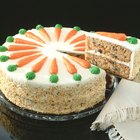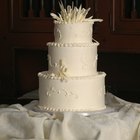
Butter's low melting temperature gives buttercream frosting a lush melt-in-your-mouth texture, but it also means the icing softens quickly on hot or humid days. Commercial bakeries cope with this by switching to shortening-based frosting, but it lacks buttercream's flavor and can feel greasy in the mouth. An alternative is adding meringue powder to your buttercream, which enables the butter-based frosting to better withstand the heat.
A Quick Buttercream Primer
Cake bakers have a large number of frostings to use for specific purposes, many of them variations on buttercream. The simplest version of buttercream simply calls for the butter to be whipped with powdered sugar and flavorings, yielding a relatively stiff product called "simple" or "American" buttercream. It's smooth and soft enough to spread evenly over most cakes, yet stiff enough to hold its shape readily when piped into decorations. Adding meringue powder to the mixture along with the powdered sugar makes it sturdier and more versatile.
Hitting the Powder
Powdered sugar is usually sold in 1- and 2-pound packages, with each pound representing 3 1/2 to 4 cups of sugar. Buttercream recipes are usually created with that in mind, and call for either 1 or 2 pounds of sugar. For each pound of sugar, add a tablespoon of meringue powder before you mix it into the butter. Cream the butter for a few minutes first, to ensure it has the correct soft consistency, and sift your powdered sugar to remove any lumps. Then add the dry ingredients to your sugar and whip it for several minutes until it's completely smooth and not gritty. Finish the icing by adding vanilla, or colorings if desired.
Dry Meringue Powder
Meringue powder contains egg whites, sugar and vanilla, just like scratch-made meringue, as well as gums and other stabilizing ingredients. The powder needs only to be mixed with water and whipped to form a long-lasting meringue. In your meringue, they bond in much the same way with the water that makes up almost 20 percent of the butter's weight. That's important, because butter begins to soften at 60 degrees Fahrenheit and begins to melt at 85 degrees. On a cake decorated with this type of buttercream, the meringue powder will keep your frosting from melting, losing its shape and ruining the appearance of your cake.
Other Benefits
The meringue powder brings a few other benefits as well. If you're using the buttercream to pipe flowers, rosettes and other decorations, adding meringue powder to the mixture will result in decorations that pipe out from your pastry bag with cleaner, sharper edges. The frosting will also harden or "crust" over a few hours, making the decorations durable enough to dry and store for later use. If you're combining decorations made with different colors of frosting, meringue powder also prevents the colors from bleeding into each other.
Related Articles

How to Keep Your Buttercream Icing With ...

How to Make Frosting Hard for a Cake

Do You Need to Refrigerate Whipped ...

Can Softened Frosting Harden Over a ...

Can I Make Brownies With Confectioner's ...
How to Make Bakery-Style Whipped Icing

The Difference Between Whipped Icing & ...

What Do You Use to Make Fondant Stick?
Best Homemade Cream Cheese Frosting

How Is Emulsified Shortening Used in ...

Softened vs. Melted Butter When Baking

Can You Use Heavy Cream When Making ...

What Will Happen if You Refrigerate ...

How to Stiffen Frosting

The Difference Between Butter Cream and ...

How to Decorate Fake Cakes

How to Get Buttercream Frosting Stiff

Cupcake Decorating Ideas Without ...

What Type of Food Coloring Is Used to ...
How to Make Frosting Bubbles for a ...
References
- The Professional Pastry Chef; Bo Friberg
- On Food and Cooking: The Science and Lore of the Kitchen; Harold McGee
- King Arthur Flour: Quick Buttercream Frosting
Writer Bio
Fred Decker is a trained chef and prolific freelance writer. In previous careers, he sold insurance and mutual funds, and was a longtime retailer. He was educated at Memorial University of Newfoundland and the Northern Alberta Institute of Technology. His articles have appeared on numerous home and garden sites including GoneOutdoors, TheNest and eHow.
Photo Credits
Creatas Images/Creatas/Getty Images